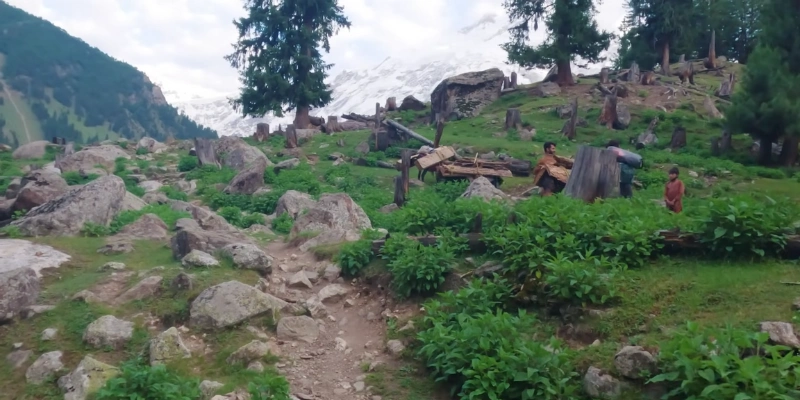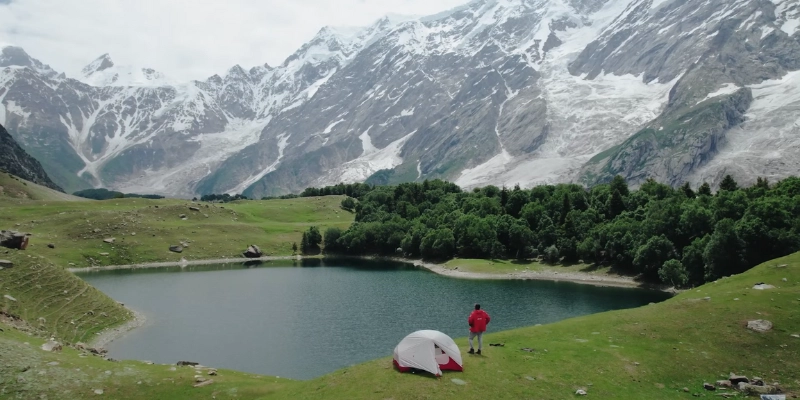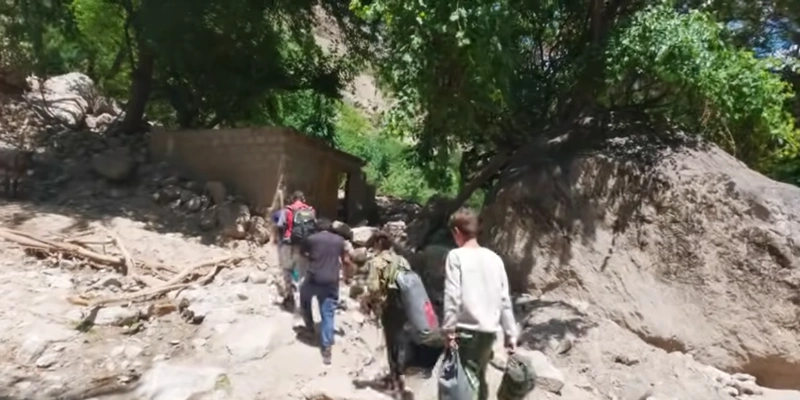Discover Haramosh Valley – Nature, Adventure & Peace
Published: 10/04/2025
Let me tell you about a quiet and beautiful place in the north of Pakistan called Haramosh Valley.
It is not very famous, so many people have never heard of it. But once you see it, you’ll remember it for a long time. There are snowy mountains, cold waterfalls, blue lakes, and peaceful places to camp. Everything here feels fresh and calm.
In this article, I’ll share how you can go to Haramosh Valley from Gilgit or Skardu, what the road is like, and what kind of weather you can expect. I’ll also tell you about some nice picnic spots, walking trails, and the beautiful Kutwal Lake. And if you plan to stay overnight, I’ll give you tips on camping and simple places to stay.
So, if you’re thinking about a trip to the north and want to see a place that feels quiet and natural, let’s begin our journey to Haramosh Valley.
Let’s explore together.
Where is Haramosh Valley Located?
Haramosh Valley lies in the heart of the Karakoram mountain range, approximately 65 kilometers east of Gilgit City in Gilgit-Baltistan, Pakistan. While technically part of the broader Skardu district, it’s most accessible via Gilgit. The valley is overshadowed by the towering Haramosh Peak, soaring to 7,409 meters (24,308 feet), a haven for mountaineers and nature enthusiasts.
- Distance from Gilgit to Haramosh Valley: ~65 km to the trailhead at Sassi village.
- Distance from Skardu to Haramosh Valley: ~130 km via the Gilgit-Skardu Road to Sassi.
- Distance from Haramosh Valley to Hunza: ~180 km (via Gilgit and the Karakoram Highway).
Its isolated setting shields Haramosh Valley from heavy tourist traffic, safeguarding its pristine charm and peaceful ambiance.

How to Reach Haramosh Valley
Getting to Haramosh Valley requires some effort; no paved highways or luxury buses here! Here’s the step-by-step breakdown:
- Reach Gilgit City: Fly into Gilgit Airport from Islamabad, Lahore, or Karachi (1–3 hour flight, weather-dependent) or take the 16–20-hour road trip via the Karakoram Highway.
- Travel to Sassi Village: Hire a 4×4 jeep from Gilgit (65 km, ~2–3 hours) to Sassi, a small settlement on the Gilgit-Skardu Road. The road is rough but manageable.
- Move to Dassu Village: From Sassi, it’s a short jeep ride or a 1–2-hour walk to Dassu (also called Dache), the last village with basic facilities.
- Trek to Kutwal Lake: The final leg is an 18–19 km trek from Dassu to Kutwal Lake, the valley’s crown jewel. Expect 8–11 hours of moderate hiking through stunning scenery.
Pro Tip: Rent a jeep and driver in Gilgit through local tour operators for a smoother journey.
Top Attractions in Haramosh Valley
Haramosh Valley is a nature lover’s dream, blending rugged landscapes with peaceful solitude. Here’s what you can expect:
1. Kutwal Lake – A High-Altitude Marvel
Nestled at 3,260 meters (10,695 feet), Kutwal Lake is the valley’s star attraction. Surrounded by Haramosh Peak (7,409 m), Laila Peak (6,096 m), and the lesser-known Mani Peak (sometimes called Dobani locally), this crystal-clear lake reflects snow-dusted mountains in a postcard-perfect scene. It’s a must-visit for trekkers and photographers.

2. Scenic Waterfalls
Along the trek from Dassu, you’ll encounter small, unnamed waterfalls cascading down rocky cliffs. These natural gems are perfect for a quick rest or a refreshing splash in summer.
3. Lush Meadows and Glaciers
The trail weaves through vibrant green meadows dotted with wildflowers (June–August) and offers close-up views of Haramosh Glacier. These spots are ideal for camping or capturing Instagram-worthy shots.
4. Ultimate Peace and Quiet
Unlike bustling Hunza or Skardu, Haramosh Valley sees minimal foot traffic. If you’re after a digital detox and a chance to recharge, this is your spot.
Weather in Haramosh Valley – Best Time to Visit
Climate significantly influences how you plan your journey. Here’s a detailed breakdown:
| Season | Temperature Range | Travel Suitability |
| Summer (May–Sep) | 10°C to 25°C (day), 0°C to 10°C (night) | Best time for trekking and camping |
| Winter (Oct–Apr) | -5°C to 5°C (day), -15°C to 0°C (night) | Not recommended due to snow and trail closures |
- Best Months: June to early September; clear skies, mild days, and accessible trails.
- Avoid November to April, when heavy snow blocks paths and temperatures plummet.
Check forecasts before heading out, as sudden rain or snow can disrupt plans.
Road Conditions to Haramosh Valley
- Gilgit to Sassi: A bumpy, jeep-friendly dirt road (~65 km). Normal cars won’t cut it—opt for a 4×4.
- Sassi to Dassu: Narrow, rocky path suitable for jeeps or a short hike (~5–7 km).
- Dassu to Kutwal Lake: No roads, just an 18–19 km trekking trail. Expect steep climbs, loose rocks, and river crossings.
Tip: Hire a local driver familiar with the terrain to avoid delays or breakdowns.

Accommodation Options in Haramosh Valley
Haramosh Valley keeps things rustic; don’t expect five-star resorts! Here are your options:
- In Gilgit: Plenty of hotels and guesthouses (e.g., Serena Hotel or the budget-friendly PTDC Motel) for a comfy pre-trek stay.
- In Dassu Village: Basic guesthouses run by locals; expect simple rooms with no frills.
- In Haramosh Valley: No formal lodging. Camping near Kutwal Lake is the way to go; bring your gear.
Camping Essentials: Waterproof tent, sleeping bag, portable stove, and enough food/water for 2–3 days.
| Trekking Tips for Haramosh Valley |
|---|
|
The trek to Kutwal Lake is moderate but demands preparation. Here’s what to know:
Route Highlight: The path climbs steadily from Dassu, crossing streams and offering panoramic views of Haramosh Peak. |

Camping in Haramosh Valley: Tips for a Magical Night
Camping under the stars in Haramosh Valley is unforgettable. The clear skies offer prime stargazing, and the silence is pure joy. Here’s how to ensure a secure and pleasant experience:
- Use a waterproof, wind-resistant tent (mountain weather can shift fast).
- Pack warm layers; nights get chilly even in summer.
- Bring a power bank; there’s no electricity or signal.
- Follow “leave no trace” principles; pack out all trash.
Safety Note: Stick to established campsites near the lake to avoid wildlife encounters.
Be self-sufficient—there are no shops past Dassu. Pack:
- Trekking shoes with a good grip
- Pack light
- Tent, sleeping bag, and mat
- Headlamp or torch (plus extra batteries)
- High-energy snacks (nuts, dried fruit, energy bars)
- Portable charger/power bank
- First-aid kit (bandages, painkillers, altitude meds)
- Warm clothing (fleece, jacket, thermals)
- Reusable water bottle (fill up in Dassu)
Final Thoughts
So, friends, we’ve now talked about Haramosh Valley, a peaceful and less-visited place in the north of Pakistan.
It is quiet, open, and full of natural beauty. There are snowy mountains, green fields, and cold rivers. Life here feels slow. The air is fresh, and the silence makes you feel calm. It is not a busy tourist place. That’s what makes it special.
If you enjoy walking in the mountains, camping under the sky, or just sitting in a quiet place, Haramosh Valley is a good choice. You won’t find many hotels or big shops here, but you will find peace, simple beauty, and real moments.
If you ever feel tired of noise and busy roads, think about visiting this valley.
Travel safe, carry only what you need, and take your time. Let the journey be slow, and enjoy every view.
And please, when you go, keep this place clean. So others can enjoy it just like you did.
Maybe one day, you’ll tell someone your own story about Haramosh Valley.
FAQs About Haramosh Valley
Haramosh Valley is in Gilgit-Baltistan, about 65 km east of Gilgit City.
Haramosh Valley is better for people who have done basic trekking before. The trail to Kutwal Lake is long and has rough, steep parts. If it’s your first trek, go with a guide and take it slow.
No special permit is needed for Pakistani citizens to visit Haramosh Valley. However, it’s wise to bring your CNIC and notify local officials before trekking. Foreigners may need permission from local security agencies.
Families can visit up to Dassu village, but the trek beyond is tough for small kids or elderly people. The valley itself is remote and has no facilities. It’s best for adults who enjoy hiking and camping.
You might spot mountain goats, marmots, and different kinds of birds. Snow leopards live in the region too, but they rarely come near humans. Always respect wildlife and don’t disturb the natural habitat.
Good news for travelers, internet and network coverage are now available in parts of Haramosh Valley! Since 2023, SCO has installed fiber connections and internet services, reaching areas like Dassu village. However, don’t expect consistent signals deep into the valley, especially on the trek to Kutwal Lake. Beyond Dassu, it’s still largely a digital detox zone, so plan accordingly and let your family know you might be offline for parts of the trip.
There are no shops or restaurants after Sassi or Dassu. You must bring your own food, like dry fruits, noodles, biscuits, or canned items. A portable stove is helpful for hot meals.
You can, but it’s not recommended unless you’re an experienced solo trekker. The path is unmarked, and there’s no phone signal in case of emergency. It’s much safer (and more fun) to go with friends or hire a guide.
It’s not dangerous if you’re careful and prepared. However, there are some steep and rocky sections where you’ll need to focus. Good shoes and a steady pace make a big difference.
Nope, no toilets or washrooms past Dassu village. It’s all natural. Carry tissue and hand sanitizer, and always follow “leave no trace” rules when using the outdoors.
If trouble hits, your guide or Dassu folks can help most. Always share your route with someone in Gilgit before you leave. Carry a basic first-aid kit and medicines.

- Be Respectful
- Stay Relevant
- Stay Positive
- True Feedback
- Encourage Discussion
- Avoid Spamming
- No Fake News
- Don't Copy-Paste
- No Personal Attacks

- Be Respectful
- Stay Relevant
- Stay Positive
- True Feedback
- Encourage Discussion
- Avoid Spamming
- No Fake News
- Don't Copy-Paste
- No Personal Attacks
